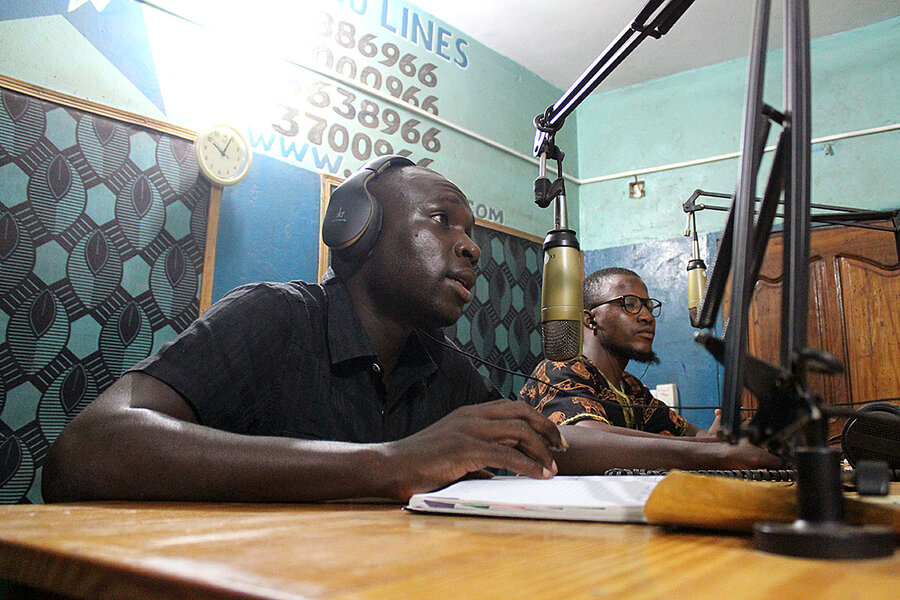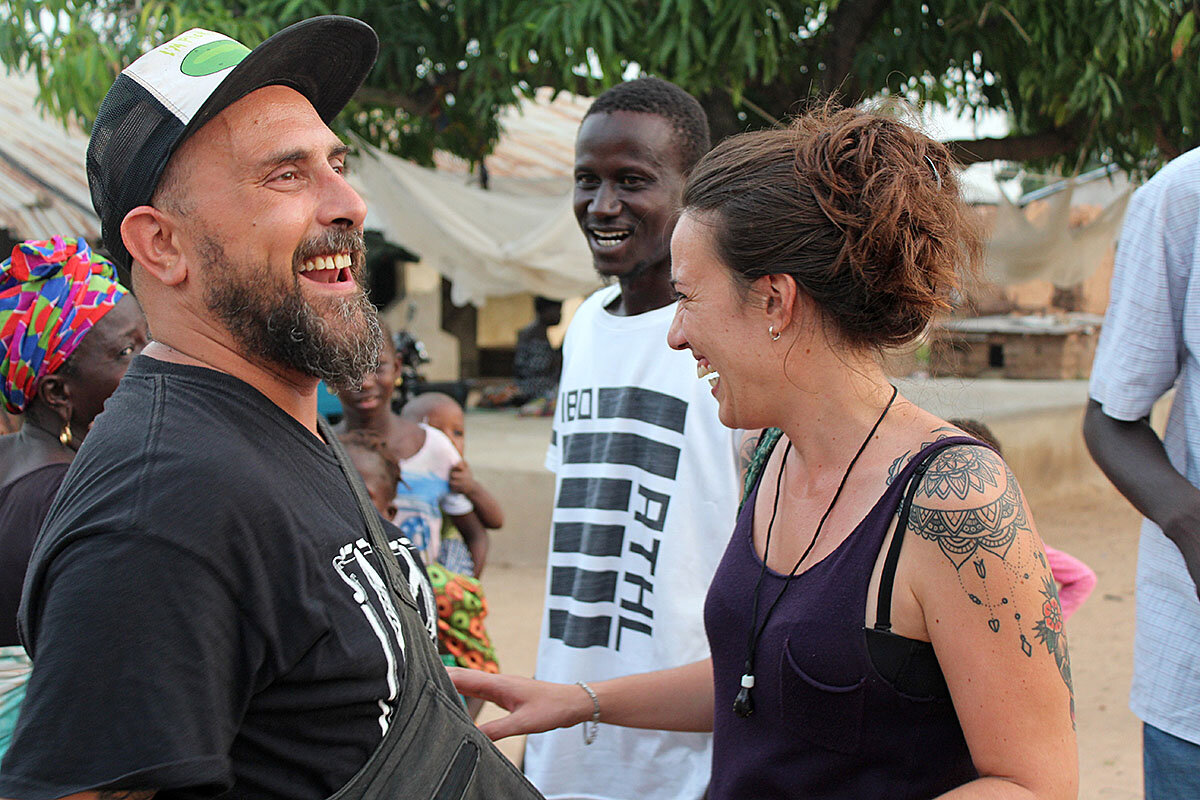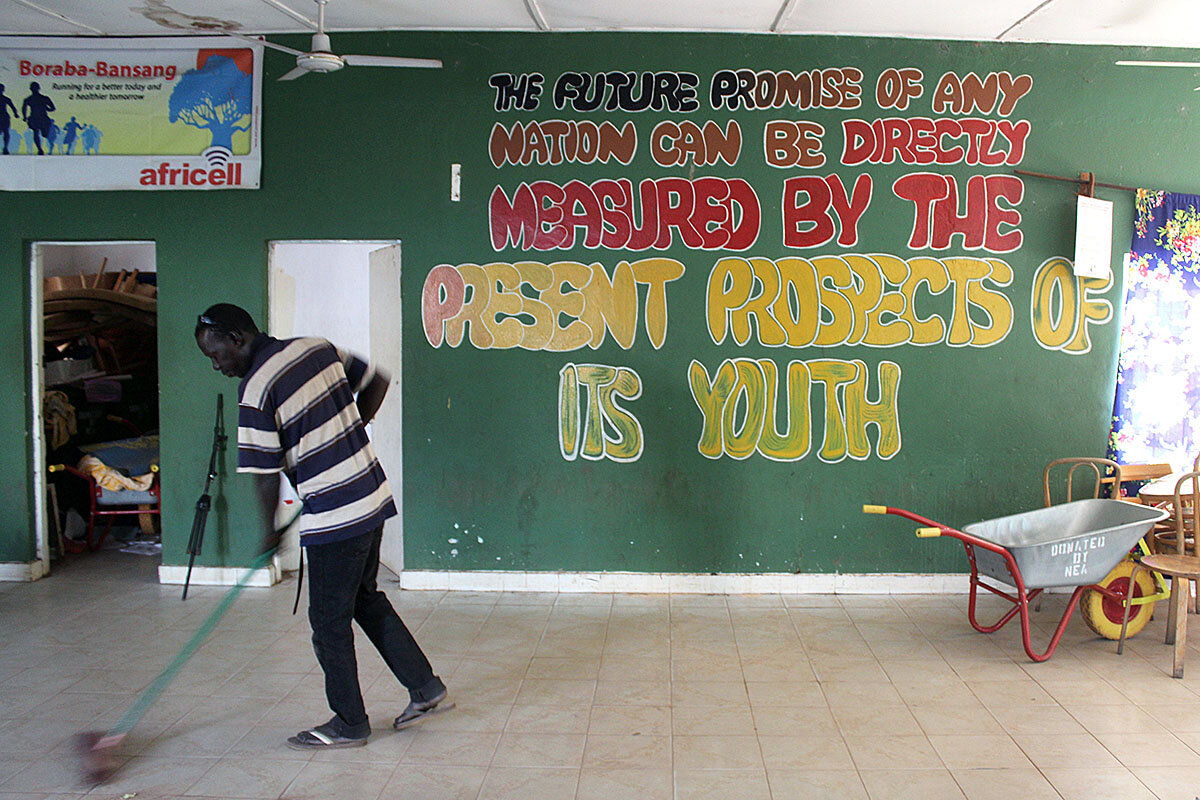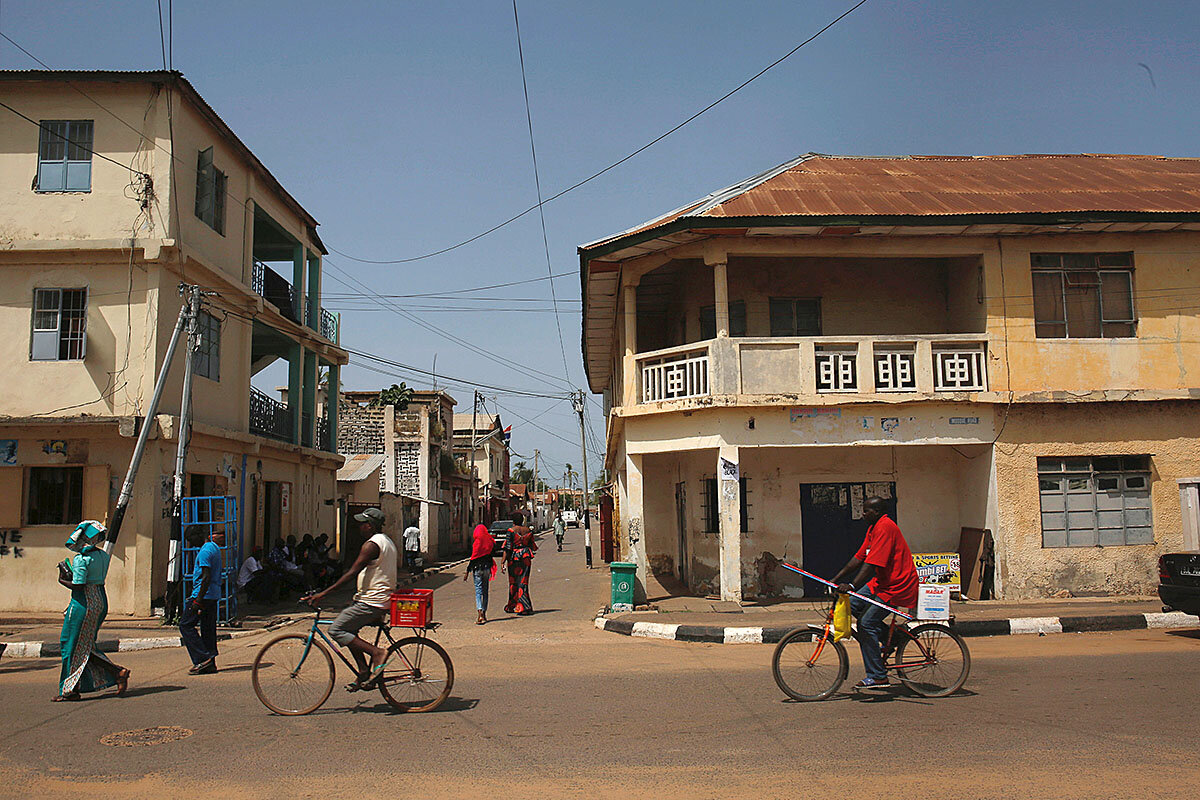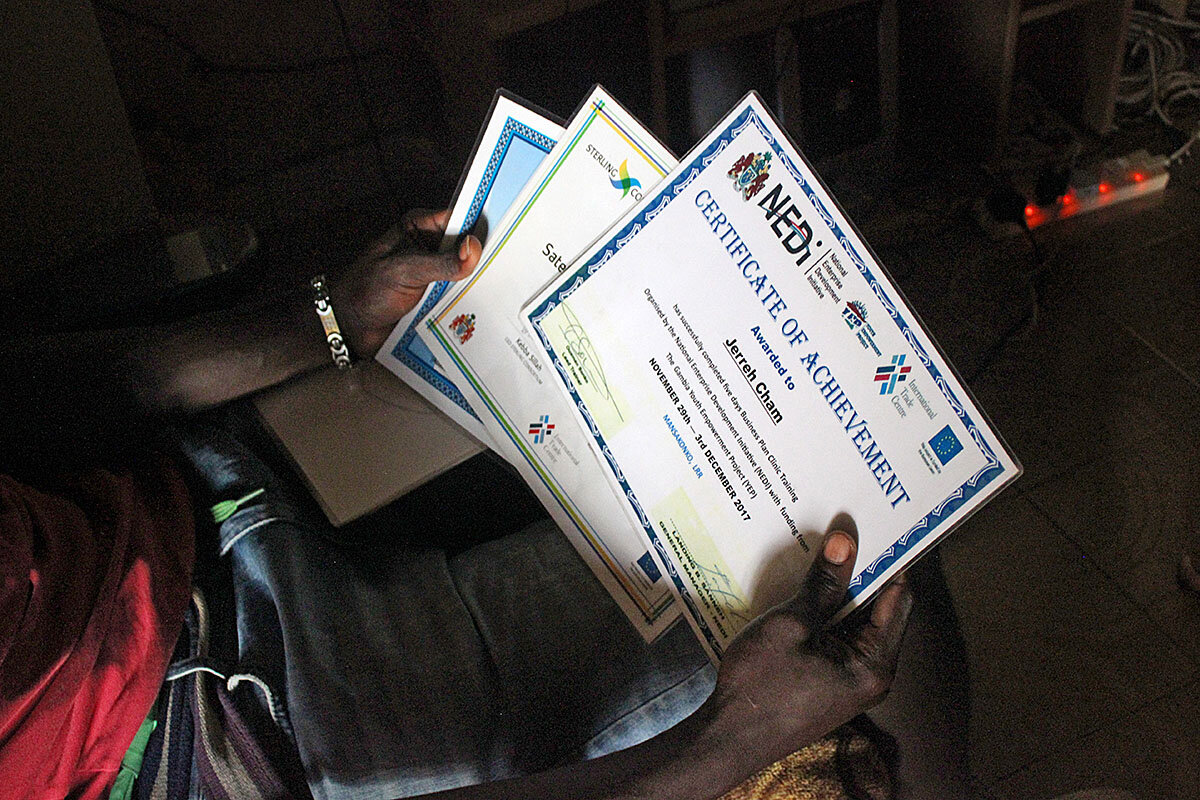EU tests idea in Gambia: Would more opportunity at home mean fewer migrants?
Loading...
| Janjanbureh, Gambia
The Story was a magnet. The Story was a compass. And in Jalamang Danso’s hometown, The Story was dragging all of the young men away.
The Story went like this: If you wanted to make a better life for your family, you had to leave. You had to cross the desert. You had to cross the sea. You had to get to Europe.
“People will say, this country is dry. There is no promise here,” says Omar Jammeh, who leads a job-creation program here in Janjanbureh, an island in the Gambia River four hours drive west of the capital Banjul. “The only promise is in Europe.”
Why We Wrote This
Job opportunities, safety – those kinds of factors guide decisions about whether to leave your country. But the pull of stories that say a better future is waiting somewhere else may be even stronger. Part 8 of On the Move: the faces, places, and politics of migration.
Mr. Danso believed it. In the pictures his old school friends sent back from their new homes in Sweden and Germany and Italy, they posed in tidy suburban streets, captured scooping piles of snow into their mittened hands or leaning against gleaming new cars. “They looked fresh,” he says, “healthy.”
And with the money they sent back, their families in Gambia ate three times a day. They paid their kids’ school fees on time. They put satellite dishes on their roofs.
Meanwhile, Danso was managing the same rundown pharmacy his father had run his entire life, in the same rundown town where he had grown up playing soccer in the empty dirt streets. But he didn’t play soccer anymore. Now, there weren’t enough young men left to form a league.
And so Danso began quietly stashing away money so that he, too, could take what Gambians call “the back way” to Europe, the treacherous overland route across the Sahara and then across the Mediterranean.
Crafting a counternarrative
The Story is so stitched into local life that it has become a sort of Gambian dream. A narrow sliver of a country with few industries or natural resources, Gambia has the highest emigration rate in Africa, according to a UNICEF analysis of Italian migration statistics. Remittances constitute 21 percent of its gross domestic product, making the country the ninth-most dependent on such money in the world, World Bank figures show.
But now the European Union is pouring hundreds of millions of euros into a large regional experiment it hopes will counter The Story.
That idea is this: If the countries currently sending migrants to Europe become better places to live, with more opportunities of their own, fewer people will want to leave them. That, in turn, will mean fewer migrants landing on Europe’s shores – or dying even before they arrive.
Gambia, in many ways, is a perfect laboratory to test this hypothesis. A squiggly tract of land running through the center of Senegal, it has a population of just 2 million. “It’s a small place, so you can make a real difference here,” says Attila Lajos, the EU Ambassador to Gambia. “And if this is the ideal circumstance, why not make it a success story?”
So billboards have sprung up across the capital, bearing a cheerful message. “You can make it here!” they chirp, beside smiling portraits of poultry farm owners and fashion designers who have benefitted from European Union-funded job creation programs.
The EU has pledged about $31 million dollars to such projects since 2017. It’s a small price to pay for a project whose goal is, in essence, to write a new version of The Story, says Foday Gassama, head of the irregular migration unit at the Gambia Immigration Department.
“A whole generation’s mindset needs to change,” he says. “At the moment, the problem is far bigger than the solutions we have. But people need role models. They need examples of people who have made it here.”
Once, it didn’t seem likely that Danso would ever be one of them.
He didn’t think Europe would make him rich, exactly. But it was better, he reasoned, to be a poor man in a rich man’s land, where at least there was money that might be made, than to be a poor man in a poor land. A poor place was like one of the pools that formed in the ruts on his street after a rain storm: still and stagnant.
He had to go.
After a year of saving, Danso planned to leave the day after the Muslim feast of Eid al-Adha, in September 2015. He handed over most of his savings to his brother, who promised to wire the money to him on his journey in installments as needed.
But instead of doing that, Danso says, his brother used the money to buy himself a bus ticket to Niger and start his own journey to Europe.
And just like that, Danso was back where he started, watching Europe through the prism of Facebook and WhatsApp. He had been wrenched out of The Story. And this time, he decided, he had to go in a different direction.
His timing was fortuitous. When elections in 2016 ended the decades-long rule of corrupt dictator Yahya Jammeh, the world rushed to shore up Gambia’s economy and democracy. International donors have pledged nearly 2 billion dollars, and some of that money – from the EU – has funded the Youth Empowerment Project (YEP), which is creating jobs in Janjanbureh, Danso’s home town.
Some of those jobs are with the small enterprise that local social activist Omar Jammeh set up to cater for foreign tourists.
Danso recalled how, when he was a kid, he would often join the knots of children waiting for the wheezing buses that would disgorge dozens of European visitors in the tourist season, hoping for a coin or a piece of candy.
But recently, Danso had begun to see the visitors’ purpose in his life differently. For a few years Mr. Jammeh (no relation to the former president) had been running a small training program for local tour guides who could earn a few dollars a day leading guests through the ruins of the town’s old groundnut warehouse and down the corridors of the white-washed colonial building from which the British once ruled the town. Danso joined, and began leading tours himself.
“I’m really motivated to sell my destination because it’s my own community,” he says. “I think tourism can bring many benefits to a place like this one.”
In 2017, money and expertise from YEP helped Jammeh expand his activities to include training courses for dozens of people working in the small tourist lodges that dot the riverbank. In the next town over, in a community center painted with cheery slogans about youth empowerment, YEP offers three-month courses in the installation of satellite dishes and solar panels.
But will such schemes dampen young people’s enthusiasm to emigrate? Not necessarily, if past lessons from elsewhere in the world are any guide, experts caution.
Almost everywhere, they point out – including in the European countries funding these new revenue projects in Africa – making poor people more prosperous has broadened their horizons, made them more mobile, and led to more people leaving, not less. It takes more than a generation to have the opposite effect, studies have shown.
That was true in places like Sweden and Italy in the late 19th century and in Latin America in the late 20th century. And it’s likely to be true in sub-Saharan Africa as well, says Michael Clemens, co-director of migration, displacement, and humanitarian policy at the Center for Global Development, a think tank in Washington D.C.
It “might be true in the long term that development will dissuade migration,” he says. “But what is understandably difficult for people to grasp is just how long the long term is.” In the meantime, he cautions, “as countries develop from poor to middle income … there will generally be more and more emigration.”
In Gambia, the number of migrants has dropped sharply in recent months. More than 3,200 Gambians have crossed the Mediterranean this year, fewer than half the 7,600 who made that journey in 2017, according to the UN High Commissioner for Refugees.
“It’s because they’re making slaves of black people in Libya,” says Bintu Beyai, a resident of a village near Janjanbureh, whose brother lives in Italy. It was a sentiment many others echo: the route to Europe has gotten too difficult, too dangerous. If you aren’t caught by Libyan kidnappers, European coast guards or border agents will get you.
Some have begun to whisper of a new route, up through Morocco to Spain, the same way the first wave of Gambian migrants reached Europe in the 1990’s. Others are plotting alternative ways out – a student visa, perhaps, or a European fiancée; maybe a relative already in Europe could sponsor the trip.
The Story has not ended, and “we can service only a small part of the need here,” admits Raimund Moser, the YEP project manager. Since last year, the program has offered job training to about 2,000 people.
For Danso, though, something has changed. On a recent evening, as the sun set in grainy pinks over the Gambia River, he led a small group of Spanish visitors on a tour of Tabanani, a village near Janjanbureh. Like many Gambian villages, it was a place without young men. A village of women and babies and old men. A place where life still revolved around The Story.
But now, after fixating for so many years on an imagined Europe, Danso saw the place differently.
It was his. It was home.




